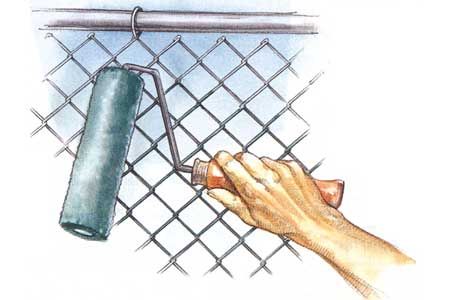A fresh coat of paint can protect a chain link fence from rust and corrosion. It can also help the fence better match your landscaping or home exterior.
Painting your chain-link fence is a simple project that you can knock out in a few days. Here’s how to do it.
Step 1: Select Your Paint
For chain link fences, aluminum paint is often the best choice. It adheres well to metal surfaces and provides rust protection. Look for paints specifically formulated for exterior metal use, as these will withstand weather conditions better than general-purpose paints. Oil-based paints can also be a good option, offering durability and a smooth finish.
Step 2: Prepare the Fence for Paint
Start by thoroughly cleaning your chain link fence to remove dirt, debris, and loose paint or rust. Use a wire brush to scrub the entire surface, paying extra attention to areas with visible rust or flaking paint. For stubborn grime, a pressure washer can be effective, but be careful not to damage the fence with too much pressure. Allow the fence to dry completely before moving on to the next step.
If the rust is extensive, consider using a chemical rust remover or renting a sandblaster for more efficient removal. Once you’ve addressed all problem areas, wipe down the fence with a damp cloth to remove any dust or debris from sanding.
Step 3: Paint the Fence
Use a long-nap roller to apply paint to both sides of the fence. Start at the top of the fence and work your way down to avoid drips on freshly painted areas. Slowly work the roller over the chain link, reaching into bends and recesses. To prevent excessive drips and runs, don’t overload the roller with paint. For areas the roller can’t reach, use a brush to apply paint carefully.
Allow the first coat to dry completely before assessing if a second coat is necessary. In most cases, two coats will provide the best coverage and durability.
Tips for a Professional-Looking Paint Finish
To achieve the best results when painting your chain link fence, consider these tips:
- Choose a calm, dry day with moderate temperatures for painting
- Use drop cloths to protect surrounding plants and surfaces from paint splatters
- Paint in sections to maintain a wet edge and avoid lap marks
- Clean your tools promptly after use to keep them in good condition for future projects
- Allow ample drying time between coats and before using the fence
Preserve the Environment
When cleaning or disposing of paint materials, follow local guidelines for hazardous waste disposal. Proper disposal is important for protecting the environment.
Cleaning Tips
Clean your brushes and rollers immediately after use with appropriate cleaning solutions. Mineral spirits are often required if using oil-based paints. For water-based paints, soap and water should suffice. Clean tools will last longer and be ready for your next project.

